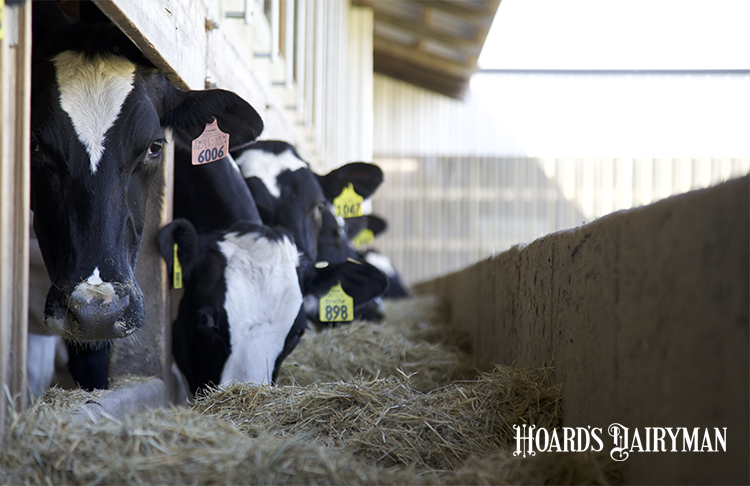
Record high feed costs and milk values are challenging traditional thoughts on feed and milk economics. Even though feed costs keep going up and up, most producers are not getting overly creative looking for ways to manage input costs. With record high milk prices in place, any slide in milk in an attempt to reduce feed costs might be a losing proposition. I like to be creative in finding feed cost advantages, but currently, it might be best to focus that ingenuity on heifer diets.
Heifer feed cost has a notable impact on dairy cash flow. For farms with a full replacement program, the cost per hundredweight of milk for heifer feed demands full attention. A good dairy person knows that for cows to give impressive levels of milk, they must eat large volumes of feed. Thus, in nearly all cases we feed lactating animals to full appetite. This, however, is not necessarily the case for growing heifers. How can we achieve the same daily gain but accomplish it with less feed intake?
Delivered in a smaller package
Growing beef animals are usually fed to appetite due to concerns of rumen health, liver abscess risk, and hoof health. This is due to the high-grain ration designed to achieve maximum weight gain. Twenty-four-hour feed availability is needed to prevent over-consumption of the high concentrate diet due to hunger. The diets built for dairy heifers, though, are much different. Being lower in grain and high in roughage, near constant rumen fill and intake patterns are less critical. This principle allows for the management or “targeting” of intakes in a dairy heifer feeding program. In short, heifers can be fed less of a more concentrated diet and have the same rate of gain and eventual milk production potential.
We should be telling our heifers how much feed they will eat and not the other way around. Using certain principles of ration formulation, we can reduce the volume of intake, reduce cost, and grow the same heifer. This is not a new principle, but some heifers are still fed to appetite. Historically, high feed costs might be the last straw to get all dairy heifers fed in this fashion.
Research conducted a number of years ago at Penn State began the trend for this practice. It is research-validated and field-approved. By concentrating nutrients, the animals are delivered the same nutrients but in a smaller package. It works. There is no need to be skeptical.
Making it work
With that being said, there are a few caveats to be considered, beginning with bunk space. Since the heifers will have a slick bunk and be hungry at feeding time, the ability for all heifers to eat in a timely fashion is important. Also, feeding rations that have a lower risk of sorting at the bunk helps ensure all animals are consuming a balanced diet.
Most ration programs have the ability to target nutrient delivery in various levels of total intake. It is true that the ingredients that are removed or lessened in the more concentrated, target-fed diet are the lower cost roughages like straw, cornstalks, or cotton burrs (gin trash). But unless these ingredients are free, the savings will be real.
The obvious question from someone with good cow sense should be related to if reduced rumen fill and overall intake as a growing heifer might result in less development of eating capacity or spring of rib in the mature animal. The research that followed target-fed heifers into lactation would suggest that this is not a concern. Results in the field have agreed.
In addition to lower intakes and reduced costs, heifers fed a more controlled diet have good lock-ups for breeding. The reduction in manure is also notable, and roughage inventory needed to feed heifers is reduced. It truly is a way to get at least the same, but with less.
Feeding heifers in this way does have a serious catch. You have to become a better heifer raiser to do it successfully. Things like managing pen counts, having consistent feeding times, and verifying silage dry matter are of enhanced importance. If you are not good at the basics, this may not be the approach for you. Is being good at these basics really an option with either feeding approach, though?
One last detail that is a benefit to target-feeding heifers is related to the ability to impact needed changes in body condition score or gain. In a fed-to-appetite arrangement, if you need to catch some heifers up a little for gain of body condition, all you can do is increase the nutrient concentration of their diet. In a target fed heifer, there is likely the ability to elevate not only nutrient density, but also intake volume to really move the needle on needed short-term weight gain. Reducing nutrient intake for overly fleshy heifers works the same way.
Telling heifers how much they will eat will put you more solidly in control of the entire heifer management system. Thinking ahead about weather changes, feed inventories, total head count, and other variables can ensure the correct nutrient delivery in at least a 10% plus or minus range of expected intake. The changes don’t look like much, but saving a pound or two of dry matter intake with $350 corn, $500 soybean meal, and even unthinkable silage prices will send a chunk of profit to the bottom line. You will still grow a nice heifer. Don’t rob tomorrow to pay for today. Instead, we can better manage input cost on the heifer program and reallocate the savings to invest in profitable milk production potential and improve the bottom line.







